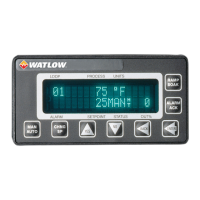CLS200 Series User’s Guide
Chapter 7: Turning and Control
134
Heat and Cool Outputs
Each loop may have one or two outputs. Often a heater is controlled according to the feedback from
a thermocouple, in which case only one output is needed.
In other applications, two outputs may be used for control according to one input. For example,
a system with a heater and a proportional valve that controls cooling water flow can be controlled
according to feedback from one thermocouple.
In such systems, the control algorithm avoids switching too frequently between heat and cool
outputs. The on/off algorithm uses the SPREAD parameter to prevent such oscillations. See Spread
on page 83. When PID control is used for one or both loop outputs, both the SPREAD parameter
and PID parameters determine when control switches between heating and cooling.
Control Outputs
The controller provides open collector outputs for control. These outputs normally control the
process using solid state relays.
Open collector outputs can be configured to drive a serial digital-to-analog converter (Serial DAC)
which, in turn, can provide 0 to 5VDC, 0 to 10VDC or 4 to 20mA control signals to operate field
output devices.
Output Control Signals
The following sections explain the different control output signals available.
On/Off
When on/off control is used, the output is on or off depending on the difference between the setpoint
and the process variable. PID algorithms are not used with on/off control. The output variable is
always off or on (0% or 100%).
Time Proportioning (TP)
With time proportioning outputs, the PID algorithm calculates an output between 0 and 100%,
which is represented by turning on an output for that percent of a fixed, user-selected time base or
cycle time.
The cycle time is the time over which the output is proportioned, and it can be any value from 1 to
255 seconds. For example, if the output is 30% and the cycle time is 10 seconds, then the output
will be on for 3 seconds and off for 7 seconds. Figure 7.5 shows examples of time proportioning and
distributed zero crossing (DZC) waveforms.
Time Proportioning (30%)
On
Off
0 3 10
Seconds
Cycle Time set to 10
Distributed Zero
0 1 3 4 6
AC Cycle
Crossing (33%)
Figure 7.5 — Time Proportioning and Distributed Zero Crossing Waveforms

